
An archer's stake was an anti-cavalry defence used by longbowmen in the 15th and 16th centuries.

An archer's stake was an anti-cavalry defence used by longbowmen in the 15th and 16th centuries.
At the Battle of Nicopolis in 1396 Turkish archers were stationed behind a barrier of stakes. This may have inspired Henry V when he instructed his men to provide themselves with six foot stakes, which were to be planted in front of them at an angle to impale horses of attacking French men-at-arms prior to the Battle of Agincourt, in 1415. [1]
There are three schools of thought about the deployment of stakes. The traditional view is that all the stakes were placed in front of the front rank to create a fence. [2] In 1976, John Keegan proposed that each archer placed his stake in front of him where he stood in the ranks, thus creating a defensive belt of stakes several yards wide within which the archers operated. [3] Keegan's proposal has been challenged by Clifford J. Rogers, who argues that most stakes were placed in a fence arrangement, with staggered gaps for archers to move through, in combination with a band of more widely spaced stakes. [4]
After the Agincourt campaign, stakes became a common piece of equipment for the English longbowman fighting in France. After the end of the Hundred Years War, stakes continued to be used, for example at the Battle of Blore Heath during the Wars of the Roses [5] and by the English mercenaries at the Battle of Montlhéry during the War of the Public Weal. [6] Tudor archers also used stakes in the early 16th century. Henry VIII's army which invaded France in 1513 carried 5000 stakes in wagons [7] and iron-bound archers' stakes are mentioned on several occasions thereafter. [8]
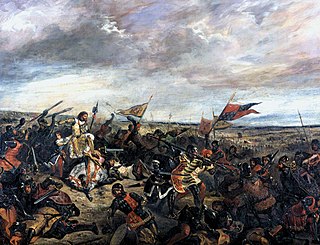
The Battle of Poitiers was fought on 19 September 1356 between a French army commanded by King John II and an Anglo-Gascon force under Edward, the Black Prince, during the Hundred Years' War. It took place in western France, 5 miles (8 km) south of Poitiers, when approximately 14,000 to 16,000 French attacked a strong defensive position held by 6,000 Anglo-Gascons.

The Battle of Agincourt was an English victory in the Hundred Years' War. It took place on 25 October 1415 near Azincourt, in northern France. The unexpected English victory against the numerically superior French army boosted English morale and prestige, crippled France and started a new period of English dominance in the war.

The English longbow was a powerful medieval type of bow, about 6 ft (1.8 m) long used by English as a weapon of war, and for hunting. English use of longbows was effective against the French during the Hundred Years' War, particularly at the start of the war in the battles of Sluys (1340), Crécy (1346), and Poitiers (1356), and perhaps most famously at the Battle of Agincourt (1415). However they were less successful after this, with longbowmen having their lines broken at the Battle of Verneuil (1424) though the English won a decisive victory, and being completely routed at the Battle of Patay (1429) when they were charged by the French mounted men-at-arms before they had prepared the terrain and finished defensive arrangements. The Battle of Pontvallain (1370) had also previously shown longbowmen were not particularly effective when not given the time to set up defensive positions.
A war hammer is a weapon that was used by both foot soldiers and cavalry. It is a very ancient weapon and gave its name, owing to its constant use, to Judah Maccabee, a 2nd-century BC Jewish rebel, and to Charles Martel, one of the rulers of France. In the fifteenth and sixteenth centuries the war hammer became an elaborately decorated and handsome weapon.

The Battle of Crécy took place on 26 August 1346 in northern France between a French army commanded by King Philip VI and an English army led by King Edward III. The French attacked the English while they were traversing northern France during the Hundred Years' War, resulting in an English victory and heavy loss of life among the French.
A schiltron is a compact body of troops forming a battle array, shield wall or phalanx. The term is most often associated with Scottish pike formations during the Wars of Scottish Independence in the late 13th and early 14th centuries.
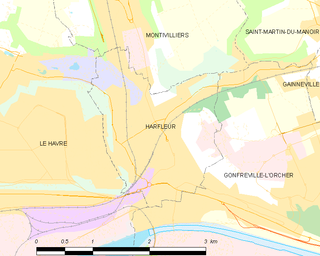
The siege of Harfleur was conducted by the English army of King Henry V in Normandy, France, during the Hundred Years' War. The defenders of Harfleur surrendered to the English on terms and were treated as prisoners of war. The English army was considerably reduced by casualties and an outbreak of dysentery during the siege but marched towards Calais, leaving a garrison behind at the port. The English were intercepted en route and fought the Battle of Agincourt, inflicting a huge defeat on the French.

Sir Thomas Erpingham was an English soldier and administrator who loyally served three generations of the House of Lancaster, including Henry IV and Henry V, and whose military career spanned four decades. After the Lancastrian usurpation of the English throne in 1399, his career in their service was transformed as he rose to national prominence, and through his access to royal patronage he acquired great wealth and influence.
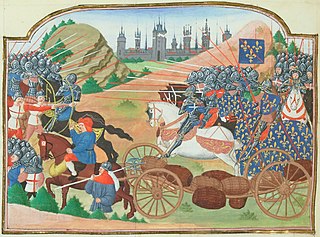
The Battle of the Herrings, also called the Battle of Rouvray, was a military action near the town of Rouvray in France, just north of Orléans, which took place on 12 February 1429, during the siege of Orléans in the Hundred Years' War. The immediate cause of the battle was an attempt by French and Scottish forces, led by Charles of Bourbon and Sir John Stewart of Darnley, to intercept a supply convoy headed for the English army at Orléans. The English had been laying siege to the city since the previous October. This supply convoy was escorted by an English force under Sir John Fastolf and had been outfitted in Paris, from whence it had departed some time earlier. The battle was decisively won by the English.

The Battle of Patay was the culminating engagement of the Loire Campaign of the Hundred Years' War between the French and English in north-central France. The French cavalry inflicted a severe defeat on the English. Many of the English knights and men-at-arms on horses were able to escape but crippling losses were inflicted on the corps of veteran English longbowmen, which was not reconstituted after the battle. This victory was to the French what Agincourt was to the English. Although credited to Joan of Arc, most of the fighting was done by the vanguard of the French army as English units fled, and the main body of the French army were unable to catch up to the vanguard as it pursued the English for several miles.

The Battle of Verneuil was a battle of the Hundred Years' War, fought on 17 August 1424 near Verneuil-sur-Avre in Normandy between an English-Burgundian army and a combined Franco-Scottish force, augmented by Milanese heavy cavalry. The battle was a significant English victory, and was described by them as a second Agincourt.
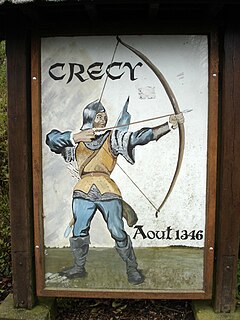
A longbow is a type of tall bow that makes a fairly long draw possible. A longbow is not significantly recurved. Its limbs are relatively narrow and are circular or D-shaped in cross section. Flatbows can be just as long, but in cross-section, a flatbow has limbs that are approximately rectangular.

The Battle of Baugé, fought between the English and a Franco-Scots army on 22 March 1421 at Baugé, France, east of Angers, was a major defeat for the English in the Hundred Years' War. The English army was led by the king's brother Thomas, Duke of Clarence, while the Franco-Scots were led by both John Stewart, Earl of Buchan, and Gilbert Motier de La Fayette, the Marshal of France. English strength was 4,000 men, although only 1,500 deployed, against 5,000 French and Scots.

Despite the rise of knightly cavalry in the 11th century, infantry played an important role throughout the Middle Ages on both the battlefield and in sieges. From the 14th century onwards, there was a rise in the prominence of infantry forces, sometimes referred to as an "infantry revolution".
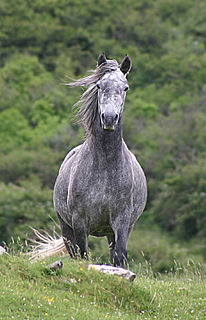
Hobelars were a type of light cavalry, or mounted infantry, used in Western Europe during the Middle Ages for skirmishing. They originated in 13th century Ireland, and generally rode hobbies, a type of light and agile horse.

Azincourt is an historical novel written by Bernard Cornwell, published in 2008. The book relates the events leading to the Battle of Agincourt through its protagonist Nicholas Hook. In the United States, it was published under the title Agincourt.
Anne Elizabeth Curry is an English historian and Officer of Arms.

William Bonville, 1st Baron Bonville, was an English nobleman and an important, powerful landowner in south-west England during the Late Middle Ages. Bonville's father died before Bonville reached adulthood. As a result, he grew up in the household of his grandfather and namesake, who was a prominent member of the Devon gentry. Both Bonville's father and grandfather had been successful in politics and land acquisition, and when Bonville came of age, he gained control of a large estate. He augmented this further by a series of lawsuits against his stepfather, Richard Stucley. Bonville undertook royal service, which then meant fighting in France in the later years of the Hundred Years' War. In 1415, he joined the English invasion of France in the retinue of Thomas, Duke of Clarence, Henry V's brother, and fought in the Agincourt campaign. Throughout his life, Bonville was despatched on further operations in France, but increasingly events in the south-west of England took up more of his time and energy, as he became involved in a feud with his powerful neighbour Thomas Courtenay, Earl of Devon.

The Battle of Bulgnéville was fought on 2 July 1431. The battle was fought between two cousins, René I d'Anjou and Antoine de Vaudémont, over partition of the Duchy of Lorraine after the death of Duke Charles II. Although René was defeated and captured, the result was reversed by diplomatic means in the years following.
The Battle of Valmont is the name given to two connected actions which took place between 9 and 11 March 1416 in the area of the towns of Valmont and Harfleur in Normandy. A raiding force under Thomas Beaufort, Earl of Dorset, was confronted by a larger French army under Bernard VII, Count of Armagnac at Valmont. The initial action went against the English, who lost their horses and baggage. They managed to rally and withdraw in good order to Harfleur, only to find the French had cut them off. A second action now took place, during which the French army was defeated with the aid of a sally from the English garrison of Harfleur.